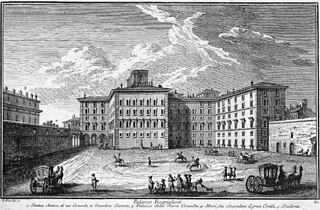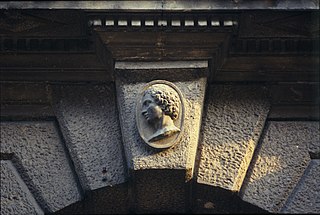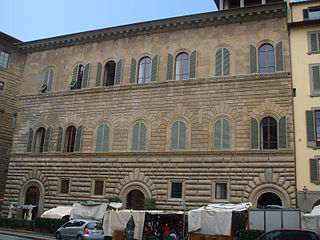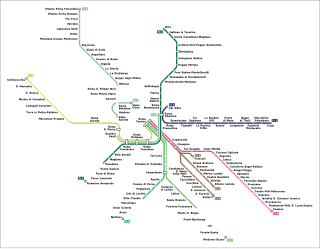

Paradiso sul mare (Paradise on the sea), Anzio, Italy, is an Art nouveau palace designed by the italian architect, Cesare Bazzani.


Paradiso sul mare (Paradise on the sea), Anzio, Italy, is an Art nouveau palace designed by the italian architect, Cesare Bazzani.
Completed in 1924, the five-story palace is located on the promenade of the Anzio shoreline.
Paradiso sul mare is today owned by the municipality of Anzio. The beautiful rooms of the Paradiso sul mare initially were destined to house the casino of the city, but the casino was never opened.
Today the palace houses a hospitality school, event space, art exhibitions and movie sets. The building has appeared in Alberto Sordi's 1973 Polvere di stelle (Stardust). In Federico Fellini's Amarcord, where it is featured as the "Grand Hotel of Rimini" and even appears on the original poster of the film designed by John Alcorn.

The Battle of Anzio was a battle of the Italian Campaign of World War II that took place from January 22, 1944 to June 5, 1944. The operation was opposed by German forces in the area of Anzio and Nettuno.

Anzio is a town and comune on the coast of the Lazio region of Italy, about 51 kilometres (32 mi) south of Rome.

Nettuno is a town and comune of the Metropolitan City of Rome in the Lazio region of central Italy, 60 kilometres south of Rome. A resort city and agricultural center on the Tyrrhenian Sea, it has a population of approximately 50,000.

Antium was an ancient coastal town in Latium, south of Rome. An oppidum was founded by people of Latial culture, then it was the main stronghold of the Volsci people until it was conquered by the Romans.
Our Lady of Ipswich was a popular English Marian shrine before the English Reformation. Among Marian shrines, only the shrine at Walsingham attracted more visitors.

The province of Pescara is a province in the Abruzzo region of Italy. Its provincial capital is the city Pescara, which has a population of 119,483 inhabitants. As of 2017, it has a total population of 319,936 inhabitants over an area of 1,230.33 square kilometres (475.03 sq mi). The provincial president is Antonio Zaffiri and the province contains 46 comuni.

Casino di Villa Boncompagni Ludovisi is a historical building in Rione Ludovisi, Rome, Italy. The building is located in the former domain Villa Ludovisi.

The Palazzo Pallavicini-Rospigliosi is a palace in Rome, Italy. It was built by the Borghese family on the Quirinal Hill; its footprint occupies the site where the ruins of the baths of Constantine stood, whose remains still are part of the basement of the main building, the Casino dell'Aurora. Its first inhabitant was the famed art collector Cardinal Scipione Borghese, the nephew of Pope Paul V, who wanted to be housed near the large papal Palazzo Quirinale. The palace and garden of the Pallavicini-Rospigliosi were the product of the accumulated sites and were designed by Giovanni Vasanzio and Carlo Maderno in 1611–16. Scipione owned this site for less than a decade, 1610–16, and commissioned the construction and decoration of the casino and pergolata, facing the garden of Montecavallo. The Roman palace of this name should not be mistaken for the panoramic Villa Pallavicino on the shores of Lake Como in Lombardy. The Palace has also been the scene of important cultural and religious events. On June 6, 1977 Princess Elvina Pallavicini invited in Palazzo Pallavicini Rospigliosi the archbishop monsignor Marcel Lefebvre for a conference on the Second Vatican Council and for the celebration of a Traditiona Mass, under the careful direction of the marquis Roberto Malvezzi, and Frigate Captain marquis Luigi Coda Nunziante di San Ferdinando. Many members of Alleanza Cattolica, the baron Roberto de Mattei, the pharmacologist Giulio Soldani, the sociologist Massimo Introvigne, the psychiatrist Mario Di Fiorino and Attilio Tamburrini and his brother Renato Tamburrini took part to the event.

Lavinio is a small sea side tourist town in the Lazio region of Italy, 50 kilometres (31 mi) southwest of Rome. It is part of the municipality of Anzio.


Sicily–Rome American Cemetery and Memorial is a World War II American military war grave cemetery, located in Nettuno, near Anzio, Italy. The cemetery, containing 7,858 American war dead, covers 77 acres (31 ha) and was dedicated in 1956. It is administered by the American Battle Monuments Commission.

The Gardens of Vatican City, also informally known as the Vatican Gardens in Vatican City, are private urban gardens and parks which cover more than half of the country, located in the west of the territory and owned by the Pope. There are some buildings, such as Vatican Radio and the Governor's Palace, within the gardens.
The 220th Coastal Division was an infantry division of the Royal Italian Army during World War II. Royal Italian Army coastal divisions were second line divisions formed with reservists and equipped with second rate materiel. They were often commanded by officers called out of retirement.

The Palazzo di Propaganda Fide is a palace located in Rome, designed by Gian Lorenzo Bernini, then Francesco Borromini. Since 1626, it has housed the Congregation for the Evangelization of Peoples and since 1929 is an extraterritorial property of the Holy See. The complex includes a dormitory and chapel as well.

Palazzo Gondi is a palace in Florence, Italy, located a block from Piazza della Signoria. It was built in 1490 under design by Giuliano da Sangallo, who was inspired by other major works of stately buildings in the city, such as Palazzo Medici and Palazzo Strozzi. Among the elements borrowed from these earlier works are the cube-shape set around a central courtyard, the ashlar sloping on each of three floors, and the arched windows.

The House of Doria Pamphilj Landi was a princely Roman family of Genoese extraction. Legend has it that the origins of the Doria family date from the early 11th century, but the authentic pedigree is traced to Ansaldo d'Oria, consul of Genoa in the 12th century. The descent of the several Doria family lines in Genoa is well-known and is described in Natale Battilana's 19th-century genealogical study of old Genoese families.

The FL8 is a regional rail route. It forms part of the network of the Lazio regional railways, which is operated by Trenitalia, and converges on the city of Rome, Italy.
The UniNettuno University, often simply abbreviated as "UniNettuno" is a private university based in Rome, Italy which provides distance e-learning courses via a consortium of 43 universities, companies, and public bodies. It was founded in 2005 with the approval of the Italian government.

Forte Sangallo, also known as the Fortezza di Nettuno, is a Renaissance fortification built on the Tyrrhenian Sea, in the historic village of the City of Nettuno, in the south of Rome. The fortification is a very popular tourist destination today with its well-preserved old quarter with narrow streets and small squares.

Cesare Bazzani was a prominent and prolific Italian architect and engineer. Active from 1911 until his death in 1939, Bazzani designed major municipal works in several cities.